COVER STORY
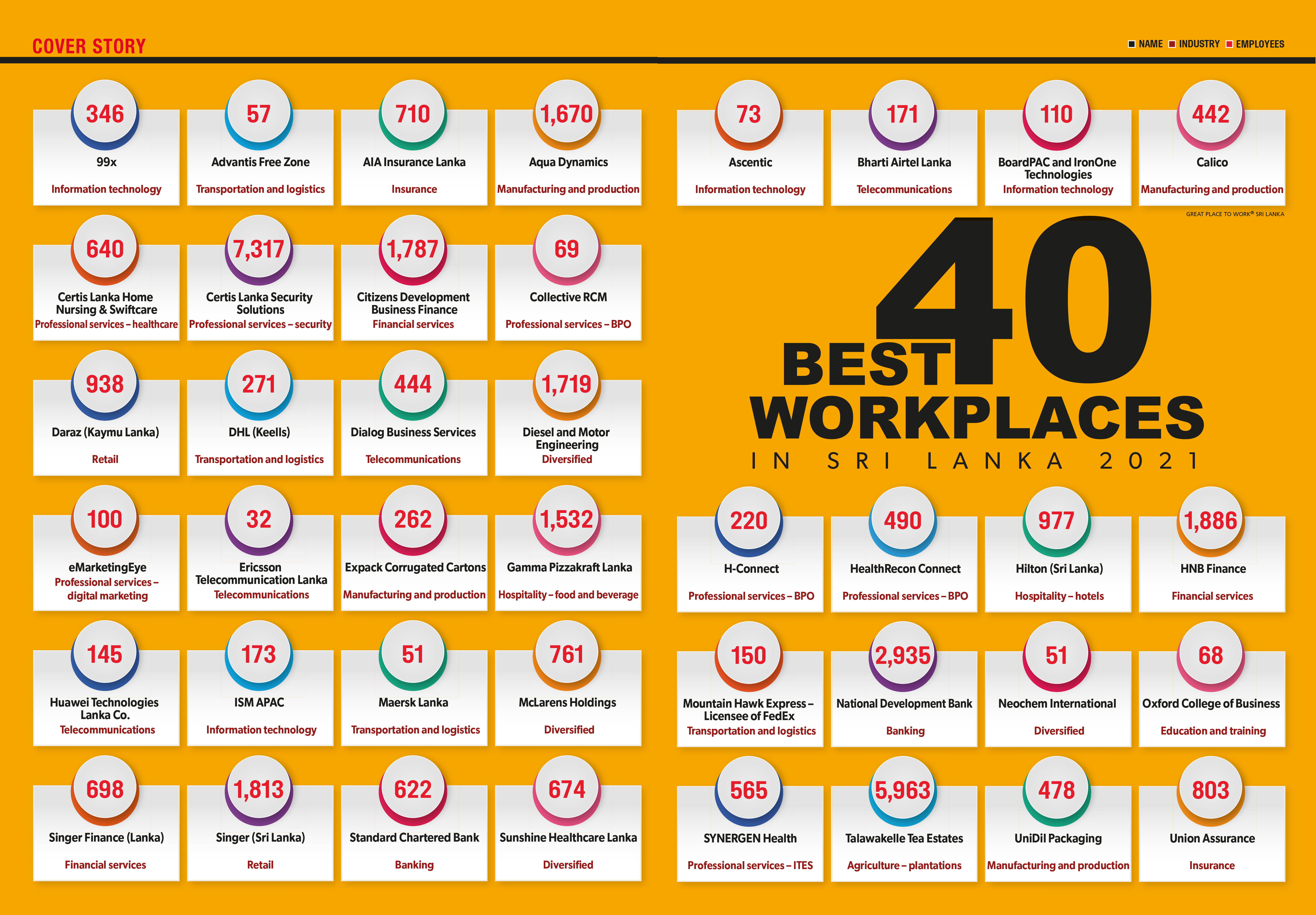
ASSESSMENT METHODOLOGY
Great Place To Work® is a pioneer that has studied and recognised Best WorkplacesTM around the world for more than 30 years. It now assesses organisations in over 70 countries across 100 territories.
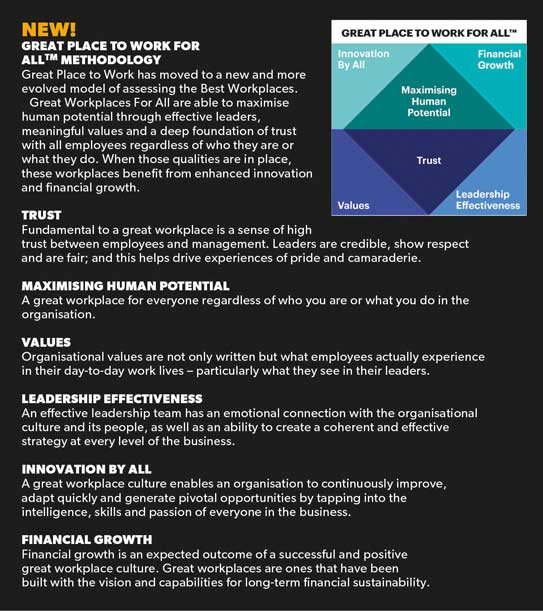
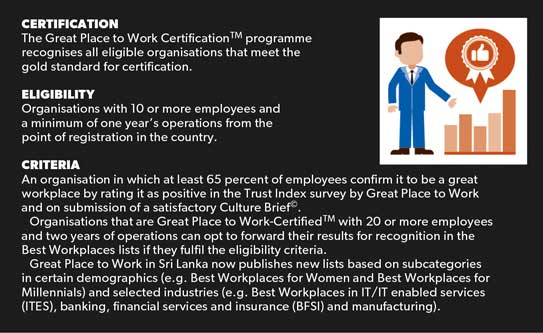
The Sri Lanka study is based on the global model and a rigorous methodology, which has been researched, tested and carried out in similar studies around the world. This model applies across all geographies as it primarily measures hygiene factors in the work environment, which are considered to be the requisite foundation of a Great Place to Work For All™.
Eighty-five percent of the Great Place to Work For All evaluation is based on the experience of trust and employees reaching their full human potential as part of their organisations, no matter who they are or what they do. These experiences are analysed in relation to each company’s size, workforce demographics and industry norms.
The remaining 15 percent of the evaluation is based on all employees’ daily experiences of innovation, their organisations’ values and the effectiveness of their leaders to ensure they are consistently experienced.
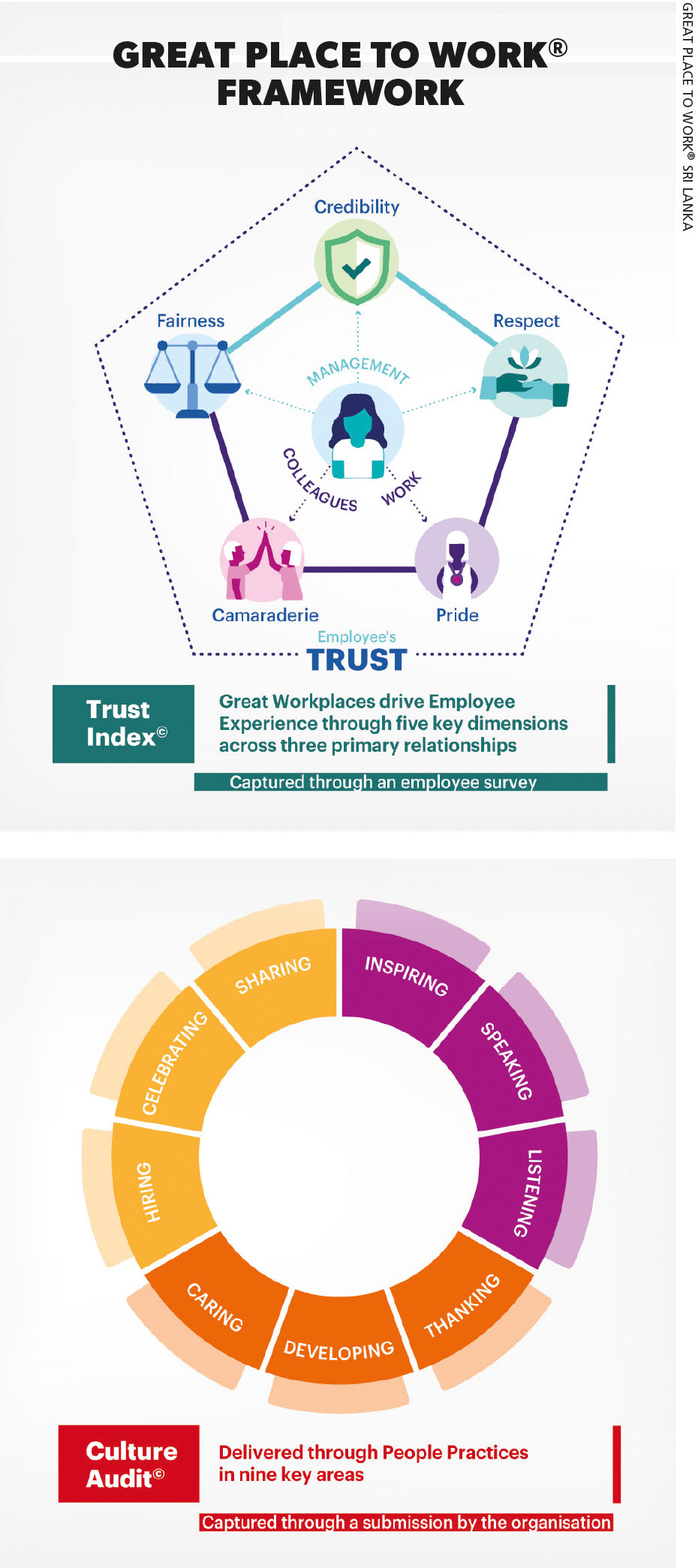
 FIRST STEP The first step to being recognised as a great workplace is to voluntarily undertake a paid assessment with a view to being certified and opting to participate in the ‘Best Workplaces’ study.
FIRST STEP The first step to being recognised as a great workplace is to voluntarily undertake a paid assessment with a view to being certified and opting to participate in the ‘Best Workplaces’ study.
While all organisations undertaking the Great Place to Work assessment have the opportunity to be certified upon meeting global standards, participants who submit their results to the Best Workplaces study will additionally be considered for inclusion in the lists of the ‘Best Workplaces in Sri Lanka’ and ‘Best Workplaces in Asia’ each year.
To qualify for the national Best Workplaces study, an organisation must have 20 or more employees and be a registered entity in Sri Lanka for two or more years.
 TWO LENS MODEL The Great Place to Work ModelTM considers workplace culture from two perspectives: the employee perspective – whereby the employee’s perceptions of the workplace experience are averaged using the Trust Index© survey; and the manager’s perspective – whereby the quality of interactions intended through people practices established by the management is evaluated using the Culture Audit© tool.
TWO LENS MODEL The Great Place to Work ModelTM considers workplace culture from two perspectives: the employee perspective – whereby the employee’s perceptions of the workplace experience are averaged using the Trust Index© survey; and the manager’s perspective – whereby the quality of interactions intended through people practices established by the management is evaluated using the Culture Audit© tool.
 EMPLOYEE EXPERIENCE A unique employee centric framework is used to measure employee perceptions through the Trust Index survey – a proprietary employee feedback tool developed by Great Place to Work.
EMPLOYEE EXPERIENCE A unique employee centric framework is used to measure employee perceptions through the Trust Index survey – a proprietary employee feedback tool developed by Great Place to Work.
Comprising 59 global core statements and using a five point Likert scale, the universal instrument measures employee experience and counts for 70 percent of an organisation’s score.
Administered in multiple modes – i.e. email, paper or kiosk depending on the organisation’s requirements – the survey is available in all three local languages.
Through two open-ended questions, the tool also captures employee comments about what makes their workplaces great and what would make them better. And it encourages employees to submit their opinions and suggestions by way of anonymous responses.
To improve, quantitative survey results can be further verified through qualitative methods such as focus group discussions with selected employee groups to gather root cases for priority areas. Coupled with survey data, this can be used for action planning by the management team.
 PARTICIPATION To be considered, organisations have to meet the Great Place to Work-CertifiedTM standard. To ensure survey results truly represent all employees, survey results have to be accurate to a 95 percent confidence level with a five percent margin of error or better.
PARTICIPATION To be considered, organisations have to meet the Great Place to Work-CertifiedTM standard. To ensure survey results truly represent all employees, survey results have to be accurate to a 95 percent confidence level with a five percent margin of error or better.
For organisations that employ less than 1,000 people, all employees were selected to participate in the survey by default while larger organisations were assessed based on a random stratified sampling method.
 EVALUATION A strict methodology for maintaining anonymity is followed so that individual responses cannot be tracked by organisations participating in the survey. A stringent audit process is followed during and after completion of the survey. This provides employees with an opportunity to provide candid feedback on the organisation to maintain the assessment’s credibility.
EVALUATION A strict methodology for maintaining anonymity is followed so that individual responses cannot be tracked by organisations participating in the survey. A stringent audit process is followed during and after completion of the survey. This provides employees with an opportunity to provide candid feedback on the organisation to maintain the assessment’s credibility.
 MANAGER’S VIEWS The manager’s perspectives and practices established by management are measured by a proprietary tool and evaluation framework called the Culture Audit. This is a comprehensive questionnaire in which the organisation submits detailed materials on the practices it has adopted, which are subject to rigorous evaluation.
MANAGER’S VIEWS The manager’s perspectives and practices established by management are measured by a proprietary tool and evaluation framework called the Culture Audit. This is a comprehensive questionnaire in which the organisation submits detailed materials on the practices it has adopted, which are subject to rigorous evaluation.
This instrument helps gauge not only an organisation’s structure and demographics, but also its philosophy and values, and the manner in which they’re integrated into its people practices. The remaining 30 percent of the overall score is derived from this Culture Audit.
 To improve, the two lens model can relate employee feedback to identify practices that may not be effective. This can be studied further through an on-site Culture Audit – a methodology comprising a series of discussions with employees, people managers and practice owners or HR to understand the implementation and effectiveness of practices submitted.
To improve, the two lens model can relate employee feedback to identify practices that may not be effective. This can be studied further through an on-site Culture Audit – a methodology comprising a series of discussions with employees, people managers and practice owners or HR to understand the implementation and effectiveness of practices submitted.
This data can be used for action planning to improve people practices in the organisation to create a better employee experience through a ‘people practice workshop.’
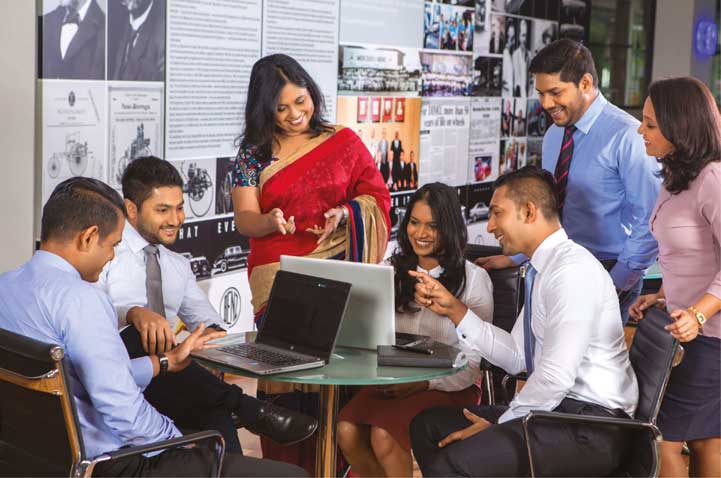
SRI LANKA’S 40 BEST WORKPLACES
Great Place to Work® presents key insights derived from its study on the Best Workplaces in Sri Lanka for 2021
The past year has been one for the books; and as we continue oscillating between adversity and recovery, the focus of organisations has turned inward as employees look to their leaders for managing direction and to their teams for adaptability. Given the circumstances, understanding the perceptions of employees and workplace cultures has never been more paramount.
Great Place to Work – as a global authority on High-Trust, High-Performance CultureTM – conducted its ninth consecutive annual study in Sri Lanka to derive insights on current workplace culture and list the 40 Best Workplaces for 2021. This study contributes to the largest global research of its kind that continues to validate the standard for a ‘Great Workplace.’
Over 100 organisations registered for the study. Great Place to Work in Sri Lanka assessed more than 32,000 employees with a response rate of 83 percent. This sample represented a population of approximately 51,000 employees among participating organisations.
This year’s study used the new and enhanced Great Place to Work For All Model for the first time in Sri Lanka. With reference to evolving work culture, the enlarged model includes additions to the fundamental trust-based model that act as supplementary pillars to differentiate the elite Best Workplaces from certified Great Workplaces.
BEST WORKPLACES Assessing the positive response to 59 standard global statements, collectively averaged as the Trust Index (or Grand Mean), employees of the 40 Best Workplaces provided a result of 85 percent positivity, which is unchanged from last year’s result.
This indicates that the 40 Best Workplaces have maintained the standard despite challenges during the pandemic year.
But the overall pulse statement of ‘taking everything into account, do you believe your organisation to be a Great Workplace?’ dropped by one percent from last year to 88 percent positivity, which may reflect the overall difficulties experienced due to the pandemic.
A Trust Index (TI) of 85 percent positive perception places Sri Lanka on a par with the average TI of other countries. The map represents the countries that have a Best Workplaces list and their corresponding employee perception averages. Perceptions are subjective and will vary according to employee expectations in the country.
The average TI employee perception score for the ‘rest’ of the organisations participating in the study amounts to 72 percent positivity, falling one point from last year.
KEY THEMES The TI is broken down further into five key dimensions. Pride is highest at 88 percent – a clear three points higher than the next – while fairness is the lowest at 82 percent positivity.
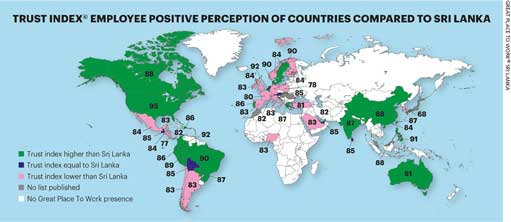
These results match the historical trend as well as general results that most organisations will garner. Comparing the results of the rest shows the same trend.
However, the gap is greatest for credibility and camaraderie, which point to the areas that the Best Workplaces are addressing more successfully than others.
The statements pertaining to ‘avoidance of favouritism,’ ‘fair profit sharing’ and ‘fair pay and promotions’ under fairness have the least positive results.

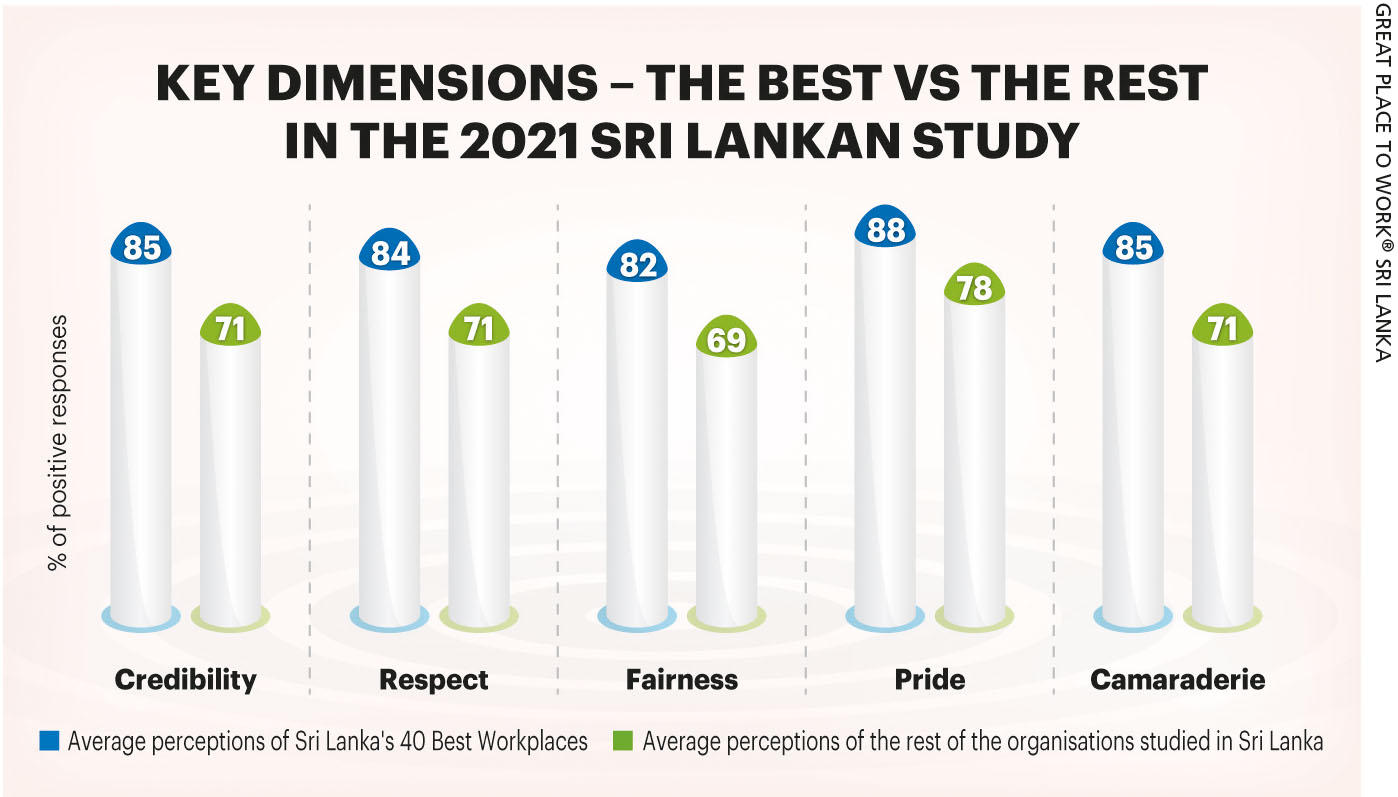
Meanwhile, the most positive statements relate to camaraderie, pride and non-discrimination by race or caste.
Notably, the highest scoring statement this year is ‘this is a physically safe place to work,’ highlighting that employees were paying particular attention to safety in the workplace given the pandemic, rewarding organisations that went the extra mile in this regard with high positivity.
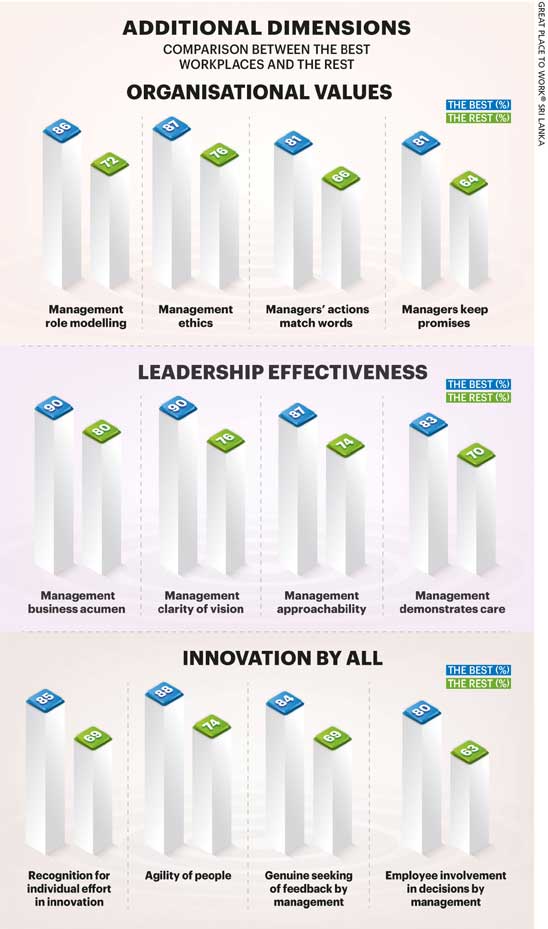 KEY DIFFERENTIATORS In addition to trust, the Great Place to Work For All expanded model incorporates the inputs of maximising human potential, organisational values, leadership effectiveness, and outputs of innovation by all and financial growth.
KEY DIFFERENTIATORS In addition to trust, the Great Place to Work For All expanded model incorporates the inputs of maximising human potential, organisational values, leadership effectiveness, and outputs of innovation by all and financial growth.
Opportunely, these areas were of particular importance given the global pandemic and the need to react to it.
Strong organisational values act as a guide to leaders when taking decisions in the face of challenges. Observing leaders who live by the organisational values bolsters employee confidence through tough times.
Significant gaps were noted between the best and the rest in this area. The Best Workplaces show a wide margin of difference from the rest particularly in management reliability in keeping promises. Naturally, this would come under scrutiny during times when working conditions were changing rapidly and employees would be looking for a sense of security.
Leadership effectiveness is seen where employees are aligned with an organisation’s strategy and everyone is working towards its implementation. The significant gaps between the best and the rest in this area are testimony to it being a differentiator for the best.
When employees were specifically questioned about their confidence in the management team, the Best Workplaces show a clear advantage over the rest.
While 87 percent of employees in the Best Workplaces show ‘a great deal’ or ‘a fair amount’ of confidence in the judgement of their management team, only 73 percent of employees in the rest feel the same with three times as many having very little or no confidence at all.

This is consistent with the two statements reflecting manager competence, resulting in a positive perception of 90 percent in the Best Workplaces.
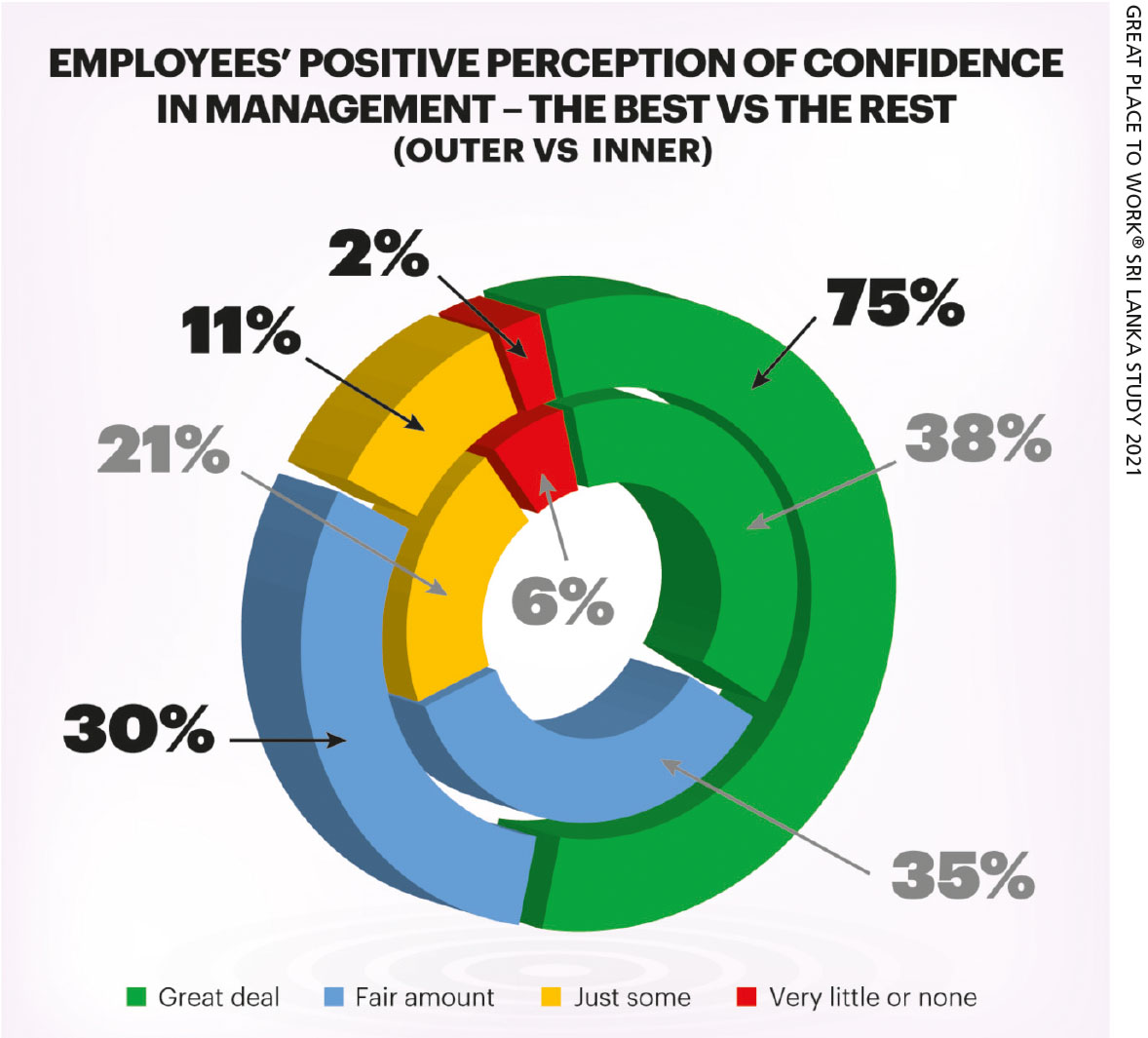 As economies expand and industries experience constant change, long-term innovation is seen as a key ingredient in any organisation. The situation over the last year or so has seen strict regulations being imposed, immediately requiring organisations to move with agility and adaptability, as well as develop new and efficient methods for continuing business in the short term.
As economies expand and industries experience constant change, long-term innovation is seen as a key ingredient in any organisation. The situation over the last year or so has seen strict regulations being imposed, immediately requiring organisations to move with agility and adaptability, as well as develop new and efficient methods for continuing business in the short term.
The ‘innovation by all’ theme measures whether the opportunity to implement improvements (which leads to long-term innovation) is provided to all employees. This facilitates a wider range of inputs being utilised by the organisation to overcome daily hurdles.
Indeed, the relevant statements demonstrate that the best differentiate themselves by encouraging and celebrating employees’ contributions to novel approaches.
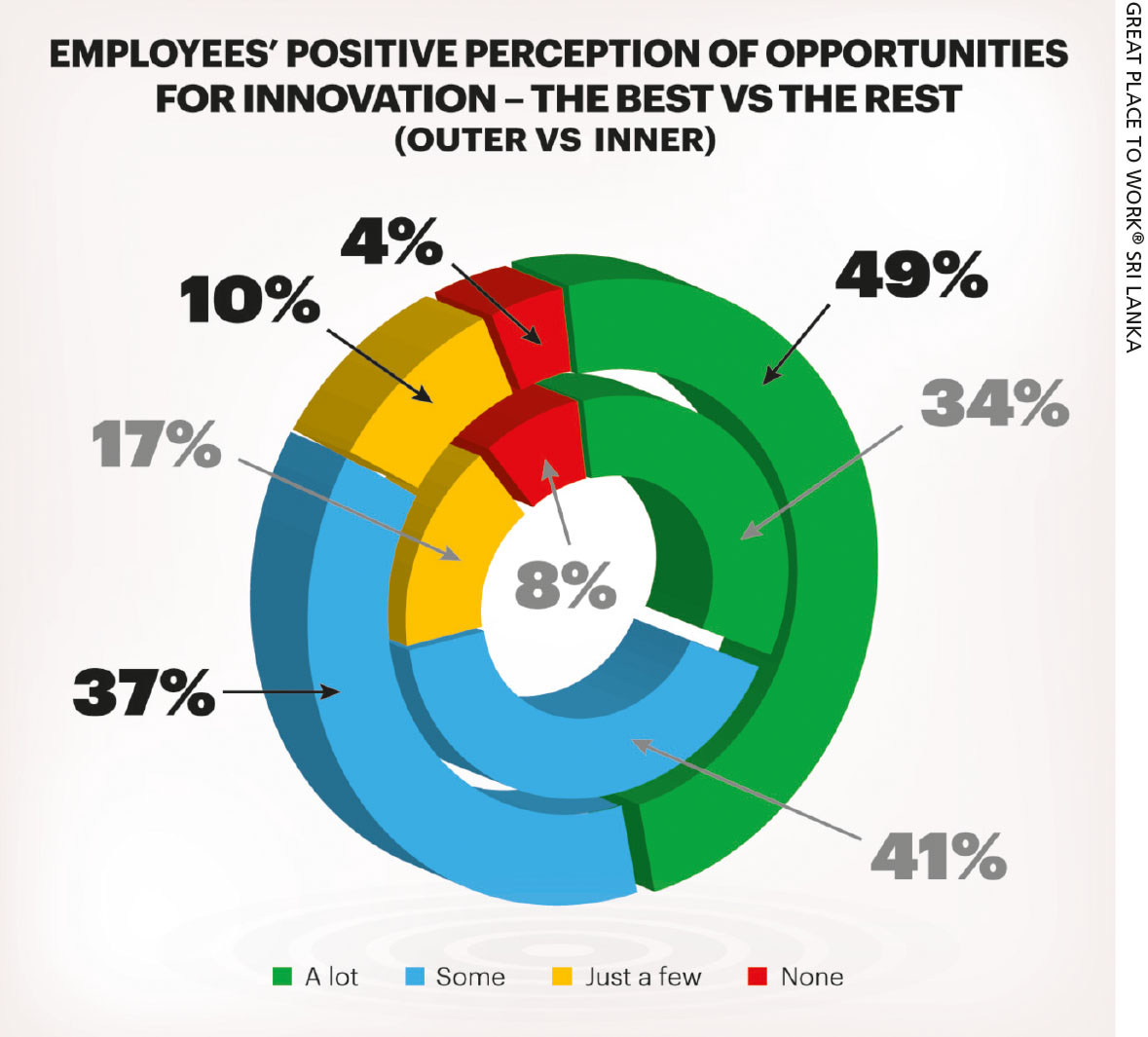 As for the results of the survey question on the availability of opportunity to contribute to innovation, 86 percent of employees in the best had a satisfactory level of opportunities whereas those in the rest had 75 percent and twice as many employees in the latter said they had no opportunities to contribute.
As for the results of the survey question on the availability of opportunity to contribute to innovation, 86 percent of employees in the best had a satisfactory level of opportunities whereas those in the rest had 75 percent and twice as many employees in the latter said they had no opportunities to contribute.
KEY DRIVERS The statements that are most correlated with the overriding pulse statement were key drivers of perception among employees who participated in the study. These are summarised for the 40 Best Workplaces for 2021 although they may vary for individual organisations.
Notably, the key drivers for the rest were the same although their employees were less positive, showing that these areas clearly need to be improved in the rest to match up to the Best Workplaces.


HEALTH INDICATORS The overall health of an organisation can be measured through five key statements related to daily motivation, discretionary effort, long-term association, pride and advocacy. With an average 10 point lead in most areas, the best outperform the rest.
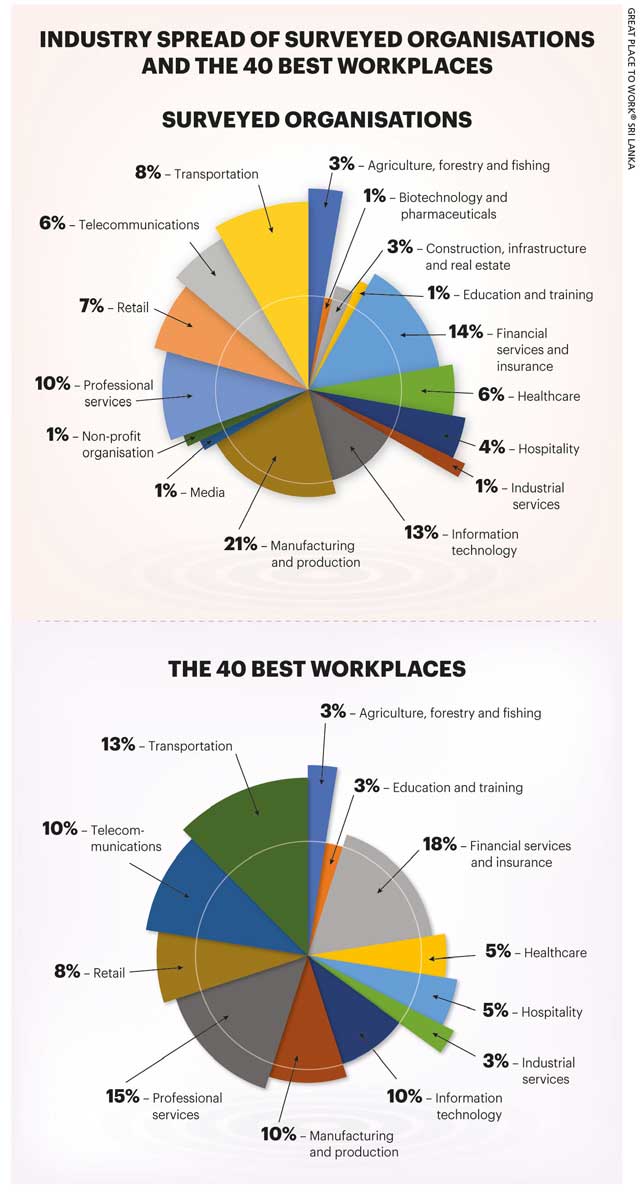 GENDER HIGHLIGHTS Promisingly, the gap between the genders is only one point among the 40 Best Workplaces with women being more positive. When studying individual statements, the average difference is not significant in most areas (at maximum, a three point difference).
GENDER HIGHLIGHTS Promisingly, the gap between the genders is only one point among the 40 Best Workplaces with women being more positive. When studying individual statements, the average difference is not significant in most areas (at maximum, a three point difference).
Women are marginally less positive about the themes of pride in personal jobs, avoidance of favouritism, work-life balance and fair promotions, while men are relatively less positive about safe infrastructure, freedom to be one’s self, job security and resources or equipment.
However, when examining the results of the rest, although women are only one point less positive than men, there are up to nine point differences in individual areas where women are less positive about the aspects of fair pay, pride in personal job, motivation, long-term association and unique benefits.
AGE GROUP HIGHLIGHTS The 26 to 34-year-old millennials remain the least positive age demographic even among the best at 81 percent compared to the highest group of over 55 years at 91 percent. The areas of least positivity are fairness in relation to compensation and promotions and work environment, as well as management reliability and work-life balance.
BEST VS THE REST The main areas where the 40 Best Workplaces greatly outperform the rest have margins of up to 20 points. Therefore, these should be key areas of focus for the rest to endeavour to improve. This gap having increased substantially by four points from last year highlights how the best maintain higher levels of trust and the ability to withstand fluctuations in perceptions in difficult periods more effectively.
INDUSTRY SPREAD Finally, with regard to the spread of industries surveyed in the study, manufacturing comprises the largest share at more than one-fifth of the total number, spanning 16 main industry sectors. Only 12 of these main industries are represented in the 40 Best Workplaces with financial services and insurance taking up 18 percent of the total.
As more organisations participate in the study, a better representation of Sri Lanka as a workplace in general will become more visible.
Current participation enables the creation of Best Workplace lists for the IT, BFSI and manufacturing sectors. Additionally, exploring different sectors enables the provision of industry benchmarks against which individual organisations can be measured.
Great Place to Work’s mission is to build a better world by helping organisations to become great places to work for all. No matter where you are in your journey, you’re invited to join in and contribute to achieving the vision of making Sri Lanka a great place to work.
FOOTNOTE For more information on how to begin your journey in creating a great workplace, contact Best Workplaces List Manager ruwani.alwishewa@greatplaceto
work.com or call 0766 301200 or 4545594 (or visit www.greatplaceto worksl.lk).
CATEGORY AWARDS
The Great Place to Work® category awards acknowledge organisations that display excellence in specific areas of people management that contribute to the fundamental goal of inspiring a great workplace culture in Sri Lanka.
Organisations that best fulfil the criteria under consideration are recognised under four award clusters: Excellence in People Initiatives (three selected practices), the Cube Award for Special Recognition, Organisation Size and Classification, and Legends (organisations listed for at least five years in a row).
 EXCELLENCE IN PEOPLE INITIATIVES Great Place to Work in Sri Lanka considers the Excellence in People Initiatives recognition as an opportunity to create awareness, and inspire best practices that support the twin objectives of nurturing and maintaining a great workplace.
EXCELLENCE IN PEOPLE INITIATIVES Great Place to Work in Sri Lanka considers the Excellence in People Initiatives recognition as an opportunity to create awareness, and inspire best practices that support the twin objectives of nurturing and maintaining a great workplace.
Winners in these categories score high in both people practices (two-thirds of the final score) as well as their respective employee perception scores (a third of the final score).
Great Place to Work’s research over the last 30 years has categorised nine practice areas that an organisation’s managers must concentrate on to create an impactful employee experience that engages employees and offers them an advantage over others.
The three practices selected for this year’s awards are of particular relevance to areas that can be better managed within the Sri Lankan workplace culture to nurture superior employee engagement. They are for excellence in two-way communication, creating an inclusive environment, and talent attraction and onboarding.
 EXCELLENCE IN TWO-WAY COMMUNICATION The award goes to an organisation that can showcase how practices in clear communication contribute to motivating employees in being aligned with and achieving organisational objectives. Good communication invites two-way dialogue; both speaking and listening practices play a vital role.
EXCELLENCE IN TWO-WAY COMMUNICATION The award goes to an organisation that can showcase how practices in clear communication contribute to motivating employees in being aligned with and achieving organisational objectives. Good communication invites two-way dialogue; both speaking and listening practices play a vital role.
Great workplaces go to great lengths to be open and transparent, set expectations, offer access to information, and have managers who are accessible as well as approachable, in order to offer opportunities to initiate conversations – and encourage employees to speak up with their suggestions and concerns.
A variety of practices to share information and capture employee feedback for incorporating people’s ideas and including people in decision-making forums are put in place. Measuring the impact of communication is also a key differentiator.
Keeping employees ‘in the loop’ enables them to better represent their teams internally as well as the organisation externally. Clear communication strategy and implementation of this enables employees to have a greater sense of connection with the organisation, feel empowered to address gaps or bottlenecks, meet managers’ expectations, choose their priorities carefully and be more productive as a result of this.
 EXCELLENCE IN CREATING AN INCLUSIVE ENVIRONMENT Diversity and inclusion in the workforce are essential for the continued success of a business in changing environments. This award is presented based on the extent to which employees perceive non-discrimination within the organisation, as well as promoting inclusivity through the various people practices.
EXCELLENCE IN CREATING AN INCLUSIVE ENVIRONMENT Diversity and inclusion in the workforce are essential for the continued success of a business in changing environments. This award is presented based on the extent to which employees perceive non-discrimination within the organisation, as well as promoting inclusivity through the various people practices.
Great workplaces use distinctive policies and programmes that create awareness around respect for diversity and harnessing its power to conduct business with customers from all walks of life; and respond to people’s needs to be valued and included fully in the workforce. Active demonstration, role modelling and the measurement of demographic spread play vital roles.
Diversity and inclusion should ideally form a key part of the business strategy – and not only the people strategy. Sponsorship from the top with a robust governance structure is required to consistently maintain diversity.
An organisation’s workforce should reflect non-discrimination and active inclusion – i.e. from different races and religions to differently abled employees – as well as promote gender balance where possible.
This will provide employees with a sense of acceptance, intimacy and community, which in turn will enable human potential to be optimised.
 EXCELLENCE IN TALENT ATTRACTION AND ONBOARDING A best practice in this area can be considered in three phases.
EXCELLENCE IN TALENT ATTRACTION AND ONBOARDING A best practice in this area can be considered in three phases.
Firstly, pre-recruitment – i.e. identifying and attracting the best fit for the organisation’s culture to ensure long-term retention and a unified team. Talent acquisition begins with a strong employer brand that attracts while maintaining entry barriers. Great workplaces create bonds through information sharing by way of early and regular engagement with talent pools.
The second phase is onboarding – i.e. being ready to receive new hires, and making the first day seamless and onboarding a memorable experience. It is also important that ‘orientation’ facilitates newcomers in understanding and taking pride in the organisation’s culture and purpose.
‘Business as Usual’ is the third phase. It entails supporting new talent in early successes by providing necessary training and challenging work following onboarding. Great workplaces involve the team in co-owning the welcoming process along with HR to improve effectiveness, and creating shared stakes in making newcomers thrive.
Aligning individual strengths with the job, effective coordination along with handover and obtaining feedback on processes are key differentiators.

CUBE AWARD FOR SPECIAL RECOGNITION
 BEST IN COVID-19 PANDEMIC RESPONSE AND CRISIS LEADERSHIP This year’s study collected information around bold acts of leadership by organisations taken in response to the COVID-19 crisis to create a Great Place to Work For All environment for employees and the community.
BEST IN COVID-19 PANDEMIC RESPONSE AND CRISIS LEADERSHIP This year’s study collected information around bold acts of leadership by organisations taken in response to the COVID-19 crisis to create a Great Place to Work For All environment for employees and the community.
It is important to understand the ways in which the pandemic impacted the business, people and the community, and how the management response reflected credibility and care.
Some of the best laid business continuity and contingency plans did not account for a pandemic and therefore, successful scenario planning and effective crisis management by the leadership team was required to navigate the new situation.
While some followed a wait and see approach, many great workplaces were proactive about quickly adapting people, practices and infrastructure to work from home (WFH), and transition to a ‘new normal’ of doing business.
Clear and constant communication across the board – with steps to stem misinformation and ensure two-way dialogue – was important in addressing ambiguity, fear and rationalisation of decisions during the crisis in order to maintain credibility.
Great workplaces refocussed on their core values and purpose. Some had to make tough decisions in terms of manpower and cost rationalisations to address business priorities, and mitigate the impact of dilemmas arising from the pandemic.
Many organisations invested in measures for employee safety and enhancing practices for demonstrating care during the crisis for stress management and work-life balance.
CATEGORY AWARDS BY ORGANISATIONAL SIZE AND CLASSIFICATION
 ORGANISATION SIZE (EMPLOYEE STRENGTH) The complexities and challenges of maintaining a great workplace culture for all employees vary with the size of the employee population.
ORGANISATION SIZE (EMPLOYEE STRENGTH) The complexities and challenges of maintaining a great workplace culture for all employees vary with the size of the employee population.
Organisations ranked among the three best in class in their respective employee strength category (Small Organisations of less than 200 employees, Medium Organisations of 201 to 750 employees, Large Organisations of 751 to 1,500 employees and Extra-Large Organisations of over 1,501 employees) are felicitated through this cluster of awards.
ORGANISATION CLASSIFICATION This includes the top MNC and PLC in Sri Lanka. The leading  multinational corporation as well as listed company in Sri Lanka are selected on the basis of the highest combined score in terms of employee perceptions through the Trust Index survey and people practices with the Culture Audit.
multinational corporation as well as listed company in Sri Lanka are selected on the basis of the highest combined score in terms of employee perceptions through the Trust Index survey and people practices with the Culture Audit.
LEGEND STATUS
Establishing and sustaining a great workplace is a journey. It takes a continued focus and dedication to a cause. Organisations that have proved commitment to employee engagement and people management by gaining a place in the list for at least five consecutive years are accepted as ‘5 Year Legends’ among the Best Workplaces and inducted into the hall of fame. HNB Finance joined the list of Legends this year.
BEST WORKPLACES IN ASIA
The Great Place to Work annual study of Asia’s Best Workplaces recognises great workplaces in the Asia-Pacific and Middle East. The size of the regional list has increased this year and will distinguish 200 organisations under three categories – 30 Best Multinational Workplaces in Asia, 70 Best Large Workplaces in Asia, and 100 Best Small and Medium Workplaces in Asia.
Moreover, the list will include results from studies in Sri Lanka conducted from April 2019 to March 2021. Thirty-seven organisations across two annual national lists in Sri Lanka will be acknowledged following the release of this list on 20 July.
FOOTNOTE Winners in each category will be announced at the Great Place to Work® Sri Lanka Best Workplaces Awards Ceremony 2021




Leave a comment